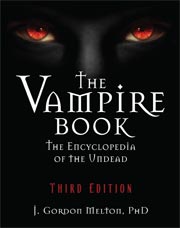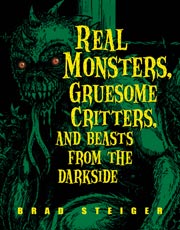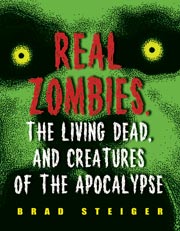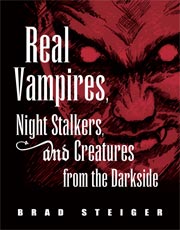Werewolf Fact of the Day
What classic tale features a character with lycanthropic tendencies?
- It was based on an actual criminal who still haunts a tavern in Scotland.
- It had been adapted for theater within a year of its publication.
- The doctor in the tale works with a drug which releases the beast in humans.
- It was written by Robert Louis Stevenson.
The ghost of the man who inspired the story of the questing scientist and his violent, monstrous dark side personality is said to haunt a tavern more than two hundred years after he was hanged for his crimes. Despite his death in the late 1700s, the Deacon Brodie Tavern in Edinburgh, Scotland, is plagued by eerie sounds, mysterious lights, and unexplained occurrences. By day, William "Deacon" Brodie was a respected businessman, but by night he emerged as a hard-drinking gambler who burglarized private homes to support his multitude of vices. An accomplice turned him in for a reward, and Brodie was hanged on the very gallows that he had helped design.
Eighty years after Brodie swung on the gallows, Robert Louis Stevenson visited the tavern and heard the tale of the man with the strange double life, and it is said to have inspired him to write The Strange Case of Dr. Jekyll and Mr. Hyde. And now today, over a 120 years after Stevenson wrote his classic story in 1886, bartender Gert Pranstatter of the Deacon Brodie Tavern, says the ghost of Brodie still haunts the place--and the terrible vision of Dr. Henry Jekyll transmutating into the evil Edward Hyde still haunts the rest of the world.
Stevenson often stated that so many of his story ideas came to him in dreams:
This dreamer, like many other persons, has encountered some trifling vicissitudes of fortune. When the bank begins to write letters and the butcher to linger at the back grate, he sets to belaboring his brains after a story, for that is his readiest cast winner. And behold the little people begin to bestir themselves in the same quest, and all night long set before him truncheons of tales upon their lighted theater....
The more I think of it, the more I am moved to press upon the world the question, 'Who are the little people?' They are near connections of the dreamer, beyond doubt--they can tell him a story piece by piece, like a serial, and keep him all the while in ignorance of where they aim.
When the "little people" in Stevenson's psyche seized upon the account of the businessman/thief in Edinburgh and transformed that germ of a story into the tale of Dr. Jekyll and Mr. Hyde, they presented him with a masterpiece revealing the potential power of the beast within the human psyche that has attained archetypal status. And there seems little doubt that the early dramatic and cinematic versions of the story greatly influenced the manner in which the transformation of humans into werewolves were portrayed in motion pictures.
Although in our own time we are familiar with an instant paperback appearing in the bookstores to accompany the latest Hollywood epic, it seems astonishing that in 1887, within a year after the publication of Stevenson's novella, Thomas Russell Sullivan had adapted The Strange Case of Dr. Jekyll and Mr. Hyde for the Boston theater. Richard Mansfield was the first actor to transform himself from the humanitarian scientist to the evil Hyde in a dramatic performance.
In 1908, William N. Selig, the first film producer to establish a studio in Hollywood, released the first motion picture version of Stevenson's story, its title now shortened to the more familiar Dr. Jekyll and Mr. Hyde. In 1909, a Danish film company released its version of the London doctor who experiments with a drug that frees the beast within to wreak chaos and death.
Carl Laemmle filmed the third production of the story in the United States in 1912, starring King Baggot and Jane Gail. By the time the great John Barrymore distorted his fabled matinee idol features to play the dual role of research chemist and monster in 1920, his interpretation was the seventh cinematic representation of Dr. Jekyll and Mr. Hyde--and four other film versions of the tale were released that same year.
An old Hollywood story has it that Barrymore, well-known for his bawdy sense of humor, so loved his grotesque Mr. Hyde makeup that he decided to wear it while house hunting in Beverly Hills. He was concerned that property owners would raise their prices once they recognized his handsome profile, but if they encountered Mr. Hyde, they wouldn't be likely to spend a great deal of time bargaining.
The 1932 screen translation of Jekyll and Hyde starred the great actor Fredric March in the dual role, aided in the on-camera transformations by the genius of Wally Westmore's cosmetic magic. March won an Academy Award for his portrayal of Jekyll and Hyde, and in 1998, Entertainment Weekly listed this classic film, directed by Rouben Mamoulian, as Number 73 on its assessment of the "Top 100 Science Fiction Movies."
Although Spencer Tracy was one of Hollywood's most dynamic actors and he was supported by an all-star MGM cast, including Donald Crisp, C. Aubrey Smith, Lana Turner, and the young Ingrid Bergman, the 1941 film doesn't quite reach the high-water mark in horror achieved by the March/Mamoulian motion picture.
Since the golden years of Barrymore, March, and Tracy, the classic Stevenson tale continues to fascinate audiences with its morality play of a decent man struggling to control the primeval monster within. Some of the recent efforts have included role reversals (Dr. Jekyll and Sister Hyde [1972]; Dr. Jekyll and Ms. Hyde, [1995]), a musical (Dr. Jekyll and Mr. Hyde, made for television [1973]), spoofs (The Nutty Professor [1963]; Dr. Heckyl and Mr. Hype, [1980]), a story told from the point of view of Dr. Jekyll's maid (Mary Reilly, [1996]), and even one version wherein Dr. Jekyll becomes a werewolf (Dr. Jekyll and the Werewolf [1971]). The most recent filming of the classic retains the original title The Strange Case of Dr. Jekyll and Mr. Hyde (2006) and stars Tony Todd in the dual role.
From The Werewolf Book: The Encyclopedia of Shape-Shifting Beings, Second Edition by Brad Steiger, (c) 2012 Visible Ink Press(R) Steiger's homage to the beast within provides meaty facts for the lycanthropic in all of us.
| < Previous Fact | Next Fact > |
Dig deeper with these related titles:
 |
The Werewolf Book: The Encyclopedia of Shape-Shifting Beings, Second Edition
When Darkness Reigns and the Full Moon Glows, Terror Emerges to Stalk the Unsuspecting…
|
ISBN: 9781578593675 $49.95 |
 |
The Vampire Book: The Encyclopedia of the Undead, Third Edition The Ultimate Collection of Vampire Facts and Fiction Death and immortality, sexual prowess and surrender, intimacy and... Read More » |
ISBN: 9781578592814 $74.95 |
 |
Real Monsters, Gruesome Critters, and Beasts from the Darkside Beware! Monsters are Everywhere Monsters have been spotted everywhere, not just slithering under a child's bed or lurking in... Read More » |
ISBN: 9781578592203 $44.95 |
 |
Unexplained! Strange Sightings, Incredible Occurrences, and Puzzling Physical Phenomena, 2nd Edition The truth is out there, but looking for it is the real fun. Now, countless X-philes and insatiable fans of the supernatural, occult, and UFOs can... Read More » |
ISBN: 9781578590704 $29.95 |
 |
Real Zombies, the Living Dead, and Creatures of the Apocalypse The macabre secret history of the undead . . . Featuring 30 chilling stories of real life zombie encounters, this comprehensive and... Read More » |
ISBN: 9781578592968 $44.95 |
 |
Real Vampires, Night Stalkers, and Creatures from the Darkside Not only do vampires exist, they walk among us! Paranormal researcher extraordinaire, Brad Steiger, reveals that real vampires are not immortal, do... Read More » |
ISBN: 9781578592555 $44.95 |




